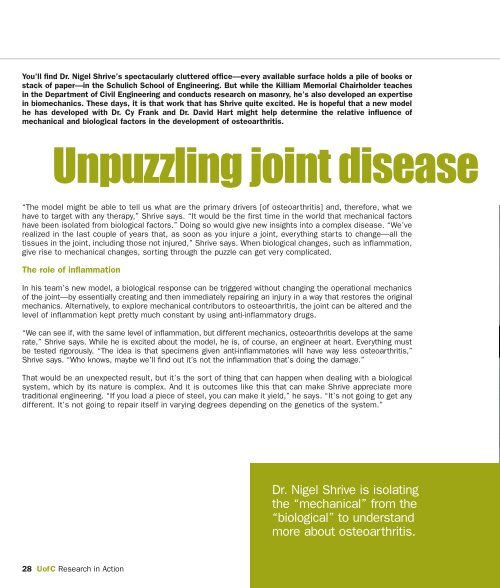Research in Action: - University of Calgary
Research in Action: - University of Calgary
Research in Action: - University of Calgary
Create successful ePaper yourself
Turn your PDF publications into a flip-book with our unique Google optimized e-Paper software.
You’ll f<strong>in</strong>d Dr. Nigel Shrive’s spectacularly cluttered <strong>of</strong>fice—every available surface holds a pile <strong>of</strong> books or<br />
stack <strong>of</strong> paper—<strong>in</strong> the Schulich School <strong>of</strong> Eng<strong>in</strong>eer<strong>in</strong>g. But while the Killiam Memorial Chairholder teaches<br />
<strong>in</strong> the Department <strong>of</strong> Civil Eng<strong>in</strong>eer<strong>in</strong>g and conducts research on masonry, he’s also developed an expertise<br />
<strong>in</strong> biomechanics. These days, it is that work that has Shrive quite excited. He is hopeful that a new model<br />
he has developed with Dr. Cy Frank and Dr. David Hart might help determ<strong>in</strong>e the relative <strong>in</strong>fluence <strong>of</strong><br />
mechanical and biological factors <strong>in</strong> the development <strong>of</strong> osteoarthritis.<br />
Unpuzzl<strong>in</strong>g jo<strong>in</strong>t disease<br />
“The model might be able to tell us what are the primary drivers [<strong>of</strong> osteoarthritis] and, therefore, what we<br />
have to target with any therapy,” Shrive says. “It would be the first time <strong>in</strong> the world that mechanical factors<br />
have been isolated from biological factors.” Do<strong>in</strong>g so would give new <strong>in</strong>sights <strong>in</strong>to a complex disease. “We’ve<br />
realized <strong>in</strong> the last couple <strong>of</strong> years that, as soon as you <strong>in</strong>jure a jo<strong>in</strong>t, everyth<strong>in</strong>g starts to change—all the<br />
tissues <strong>in</strong> the jo<strong>in</strong>t, <strong>in</strong>clud<strong>in</strong>g those not <strong>in</strong>jured,” Shrive says. When biological changes, such as <strong>in</strong>flammation,<br />
give rise to mechanical changes, sort<strong>in</strong>g through the puzzle can get very complicated.<br />
The role <strong>of</strong> <strong>in</strong>flammation<br />
In his team’s new model, a biological response can be triggered without chang<strong>in</strong>g the operational mechanics<br />
<strong>of</strong> the jo<strong>in</strong>t—by essentially creat<strong>in</strong>g and then immediately repair<strong>in</strong>g an <strong>in</strong>jury <strong>in</strong> a way that restores the orig<strong>in</strong>al<br />
mechanics. Alternatively, to explore mechanical contributors to osteoarthritis, the jo<strong>in</strong>t can be altered and the<br />
level <strong>of</strong> <strong>in</strong>flammation kept pretty much constant by us<strong>in</strong>g anti-<strong>in</strong>flammatory drugs.<br />
“We can see if, with the same level <strong>of</strong> <strong>in</strong>flammation, but different mechanics, osteoarthritis develops at the same<br />
rate,” Shrive says. While he is excited about the model, he is, <strong>of</strong> course, an eng<strong>in</strong>eer at heart. Everyth<strong>in</strong>g must<br />
be tested rigorously. “The idea is that specimens given anti-<strong>in</strong>flammatories will have way less osteoarthritis,”<br />
Shrive says. “Who knows, maybe we’ll f<strong>in</strong>d out it’s not the <strong>in</strong>flammation that’s do<strong>in</strong>g the damage.”<br />
That would be an unexpected result, but it’s the sort <strong>of</strong> th<strong>in</strong>g that can happen when deal<strong>in</strong>g with a biological<br />
system, which by its nature is complex. And it is outcomes like this that can make Shrive appreciate more<br />
traditional eng<strong>in</strong>eer<strong>in</strong>g. “If you load a piece <strong>of</strong> steel, you can make it yield,” he says. “It’s not go<strong>in</strong>g to get any<br />
different. It’s not go<strong>in</strong>g to repair itself <strong>in</strong> vary<strong>in</strong>g degrees depend<strong>in</strong>g on the genetics <strong>of</strong> the system.”<br />
28 U<strong>of</strong>C <strong>Research</strong> <strong>in</strong> <strong>Action</strong><br />
Dr. Nigel Shrive is isolat<strong>in</strong>g<br />
the “mechanical” from the<br />
“biological” to understand<br />
more about osteoarthritis.

















